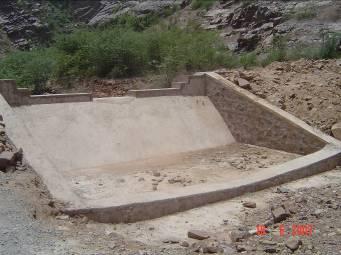HARVESTING WATER HARNESSING LIFE
A Case Study of Kotla Village in Mewat
MEWAT: STATISTICS AT A GLANCE
| People | Meo Tribals |
| Geographical Location | Foothills of Aravalis |
| Average rainfall | 336mm-500mm |
| Occupation of villagers | |
| a) Agriculture & Animal Husbandry b) Others | 58% 42% |
| Cultivated area | 80% |
| Irrigated area | 44% |
| Source of water for irrigation | Ground water- 95% |
| Water Quality | Mostly brackish |
| Ground water depletion rate | Over 25cms a year |
KOTLA CASE STUDY:
 Kotla is a village at the foothills of Aravallis. It has the worst development indices. Kotla situated at the foothills of Aravallis has rain water streams which carry the precipitated rain water from the hilltops. There is a vast catchment area uphill as it lies very close to the Aravalis. With no obstruction in way, the water used to flow through the village streets bringing tonnes of small rocks from the hills and because of high gradient, no water percolated under the ground. Because of high ground gradient this run off used to flow very fast. The concentration time over the ground was very less resulting in minimal percolation. At the same time the high velocity of flow caused erosion to top fertile soil in agricultural fields.
Kotla is a village at the foothills of Aravallis. It has the worst development indices. Kotla situated at the foothills of Aravallis has rain water streams which carry the precipitated rain water from the hilltops. There is a vast catchment area uphill as it lies very close to the Aravalis. With no obstruction in way, the water used to flow through the village streets bringing tonnes of small rocks from the hills and because of high gradient, no water percolated under the ground. Because of high ground gradient this run off used to flow very fast. The concentration time over the ground was very less resulting in minimal percolation. At the same time the high velocity of flow caused erosion to top fertile soil in agricultural fields.
In the absence of recharging, ground water was depleting at more than 300-500 mm every year. To encounter this situation, we adopted the concept of storing and percolation of the same in the ground with ridge to valley approach. Ridge to valley approach was unique as it was able to reduce the flow velocity, and minimize the chances of erosion in the agricultural fields and silting in storage basins helping to increase the recharging potential. This was carried out through a series of check dams wherever possible with the idea that backwaters of a check dam touch the preceding check dam in the stream such that the whole length of this stream becomes storage and percolation basin.
There was only a 200 meter wide stretch under the hills where fresh ground water was available; otherwise rest of the village had saline ground water. Farmers of this village used to grow rain fed mustard and tomato only if some one had a tube well within these 200 meters. This stretch of 200 meter today used to be much wider few years back. Last year this stretch had shrunk to 100 meters in some patches and even the public water supply tube well started yielding saline water. The fresh water pockets were depleting year by year due to high exploitation of these.
INTERVENTION:
To address the problem two check dams were proposed in the village. Community contribution was the most difficult task in this project but we went ahead with the project with whatever minimal contribution we received and the work was completed in June 2007. Although the monsoon was not satisfactory this year but to our satisfaction we could harvest the rains to the extent that villagers for the first time in their lives noticed a rise of water table by 7 feet in the open wells.
During the last few years we observed that in one monsoon season (July-September), the entire basins were filled with rain water and percolation happened 10 times more. The harvested rain water was more than 10 times of the storage capacity of a check dam.
Harvesting statistics at a glance:
Kotla
Stoarge Area (SM): 26000
Annual Rain Water Harvesting (in Kilo litres): 507000
Apart from the check dams, the abandoned dry wells have been transformed to harvesting structures by diverting the rainwater into the abandoned wells. A filtration mechanism is worked out as these wells are structurally well connected with the aquifer harvesting a significant amount of rain water. There are many examples where the dried abandoned wells are now having water because of rise in ground water table. All this could be possible only because of greater harvesting and recharging of ground water table.
In Kotla, the construction of two check dams has improved the quality of water and increased ground water table. One farmer whose tube well was more than 500 meters away from the check dam, reported that his tube well is now delivering sweet water which used to be saline previously and this could be possible because of the rain water harvested by the check dam.
For More Information, Contact:
The Sehgal Foundation
Lalit M Sharma, Pooja Murada
289, Sector 17A, Gurgaon, Haryana-122001, INDIA
Phone: 91-124-2397621/2397622/50101426
Website: Click here













